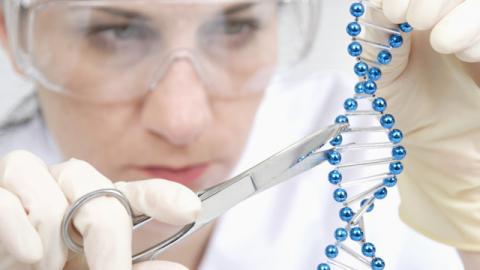Second generation CFTR gene repair
Investigating the permanent correction of more than 80% of mutations causing disease in human cystic fibrosis cells.

The Trust is funding a study, led by Dr Patrick Harrison at University College Cork, looking at developing the next generation of genetic therapy for cystic fibrosis. If successful, this study will allow permanent correction of more than 80% of cystic fibrosis mutations in cultured lung cells.
The human genome contains the recipe for life. While minor changes to the recipe make life interesting, some changes can cause genetic diseases like cystic fibrosis. When baking, the typing error "bake at 170°C" instead of "bake at 180°C" wouldn’t make much difference, whereas "cool for two hours" versus "cook for two hours" could spoil everything. Cystic fibrosis is caused by tiny, yet crucial 'typing' errors in the CFTR gene and the ultimate goal of gene therapy is to stop and reverse the disease in an individual by correcting these 'typos' to restore normal CFTR gene function.
The aim of conventional gene therapy is to achieve this by 'gene addition', which means putting an additional copy of the correct gene into the cells. This can be likened to sticking a recipe correction into the front of a cook book which contains the typing error. However, although gene addition has worked well in isolated cystic fibrosis cells it has not yet been as successful in cystic fibrosis patients.
Gene addition also has some potential limitations:
- it only puts some of the missing information back – like the correction note, there’s not enough room for all the information so the full instructions are not included; and
- gene addition is not permanent, just as added inserts eventually fall out of books.
An alternative to gene addition is to actually repair the gene. In 2012 Dr Harrison and his colleagues developed this technique and showed it could permanently correct the most common F508del mutation in cystic fibrosis cells. The new study is to investigate a 'second generation' approach to gene repair; looking at whether it is possible to repair a much wider range of mutations within the gene by effectively cutting out a stretch of DNA where the six most common CF-causing mutations (and more than 80% of the rarer ones) are located, and replacing this region with the normal sequence.
The corrected stretch of DNA is delivered into the cells in exactly the same way as it is for traditional gene therapy, and once inside the cell it then makes its way to where the DNA is stored. The stretch of DNA containing the mutation is identified and tiny 'cellular scissors' called nucleases then cut out the mutated stretch of DNA and replace it with the new stretch of DNA. The advantage of gene repair over gene addition is that the correction lasts for the lifetime of the cell and the protein is made as and when the cell needs it, meaning that you end up with a cell that looks and behaves exactly the same as a healthy cell.
In our analogy, this would be like cutting out the page containing the typing error and replacing it with a new, permanently corrected one. Of course this is much more difficult than just adding a note in the front, and similarly gene repair has more technical challenges to overcome than gene addition. The main technical challenge with gene repair is finding the section of DNA that needs to replaced and getting the scissors to the right place. Until recently this has been done with molecules called Zinc Finger Nucleases, which recognise certain 'landmarks' in the DNA. The nearer the landmark is to the stretch of DNA to be replaced, the more successful the gene repair is; unfortunately the nearest landmark for lots of cystic fibrosis mutations is still further than ideal, which makes the process of gene repair quite inefficient.
It is vital to have efficient gene repair because the more individual cells that can have their gene corrected, the more likely it is to lead to a clinical benefit in the lungs. Dr Harrison will therefore also be using a new technique which uses a system called CRISPR/Cas9 to recognise the DNA. This system has the advantage that it can be designed to recognise virtually any region in the DNA, making it possible to direct the scissors very close to the mutations and hopefully increase the efficiency of the gene repair.
While this work aims to confirm the technique works in individual cystic fibrosis cells, there are a number of additional steps before this approach can be tried in CF patients. However, a similar strategy has proved successful in a pre-clinical model of haemophilia, and a first generation gene repair strategy has already entered into early stage clinical trials for another disorder.
Dr Harrison said: "Second generation gene repair strategies combine the advantages of gene addition (correction of a wide range of mutations) and gene repair (permanent correction and normal gene expression). If we can provide proof-of-principle that it works in human cells, and establish that genetic correction also results in functional correction, the next step is to verify long-term stability and safety."
Research we fund
We fund research to tackle some of the most pressing issues in CF today. Find out how your donations are making a difference.
What is CF?
Cystic fibrosis, or CF, affects the lungs, digestive system and other organs, and there are over 10,600 people living with it in the UK.
Contact us
Get in touch with us to speak to someone on our Helpline, find out about an event or speak to our Press Team.
